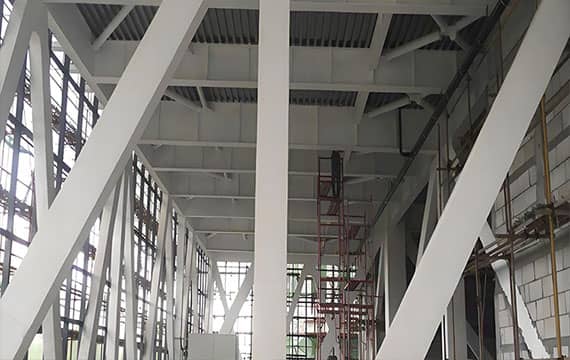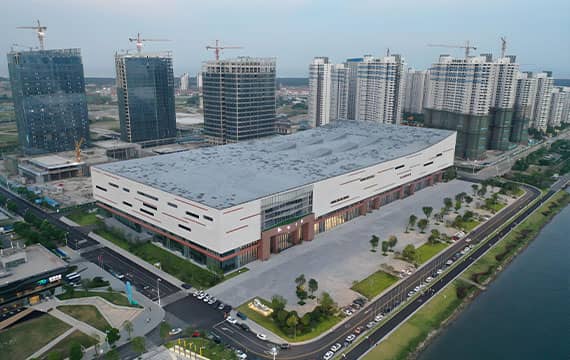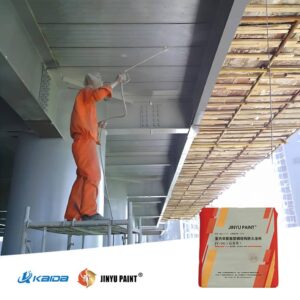Description
STI-A is a high-performance indoor non-intumescent fire retardant paint for steel structures, featuring a two-component, cement-based, water-based formulation that utilizes non-toxic, odorless inorganic materials to ensure no harmful emissions during application, service, or fire incidents. This premium fireproof coating delivers exceptional passive fire protection with low smoke emission (AQ1 certified) and minimal toxicity, effectively delaying heat transfer to steel substrates while maintaining structural integrity during fires. With 1-3 hour fire ratings compliant to GB14907-2018 standards and CCCF certification, this non-combustible solution is ideal for industrial plants, commercial buildings, and infrastructure projects requiring reliable indoor steel fire protection. The coating’s low thermal conductivity provides superior resistance to temperature transfer, making it a safe, durable choice for critical structural applications where smoke suppression and environmental safety are paramount.
Key features:
✔ Low smoke & toxicity – Minimal smoke emission (AQ1 certified)
✔ Passive fire protection – Delays heat transfer to steel substrates
✔ Non-combustible & low thermal conductivity – Effectively resists fire for 1-4 hours
✔ Wide compatibility – Works with epoxy zinc-rich primers for optimal adhesion
Certifications & Test Reports
STI-A complies with China’s GB14907-2018 standard, offering certified fire ratings:
1.0h, 1.5h, 2.0h, 2.5h, 3.0h, 4.0h
CCCF certified (China Compulsory Fire Product Certification)
AQ1 toxicity rating (low smoke hazard)
| Product Code | Test Report No. | Bond Strength (MPa) | Actual Fire Rating (h) | Thickness (mm) | Usage (kg/m²) |
|---|---|---|---|---|---|
| GT-NSF-Fp1.00-STI-A | Gn201905429G1 | 0.16 | 1.27 | 15 | 9.75 |
| GT-NSF-Fp2.00-STI-A | 2019700968A | 0.26 | 2.46 | 25 | 16.25 |
| GT-NSF-Fp3.00-STI-A(4h) | 2019700966 | 0.26 | 4.00 | 40 | 26 |
Surface Preparation Guidelines for Indoor Fire Retardant Paint Application on Steel Structures
Primer System Requirements
After sandblasting, steel surfaces must be coated with a compatible anti-corrosion primer system. We recommend the “Jinyu” brand epoxy zinc-rich primer combined with epoxy micaceous iron oxide intermediate coat for optimal adhesion with the indoor fire retardant paint for steel.
Both primer and intermediate coats must form a continuous, unbroken film to completely seal the substrate, preventing potential delamination of the fireproof coating and substrate corrosion.
Alternative Primer Compatibility Testing
When using other primer systems, mandatory compatibility testing must be conducted either by certified laboratories or through on-site brush-out tests to ensure proper bonding with the non-intumescent fireproof coating.
Application Restrictions
Never apply fire resistant paint for steel directly onto:
✓ Unprimed steel surfaces
✓ Galvanized coatingsDirect application may lead to coating failure and accelerated steel corrosion.
Pre-Application Inspection
Before applying the indoor fire protection coating, thoroughly inspect for:
✓ Complete primer coverage
✓ Surface contaminants (dust, oil residues)
✓ Structural defects (cracks, inadequate welds)Application of the cement-based fireproof coating should only proceed after passing all inspections.
Application Guide
Base Layer (Textured):
Mix STI-A powder : adhesive = 1:1, add water, and spray to 3–4mm thickness. Cure for 24h.
Main Coating:
Mix STI-A powder : adhesive = 4–5:1. Spray in 6–8mm layers (0.5–0.6m nozzle distance, 0.6–0.8MPa pressure).
Reinforcement:
At ~10mm thickness, embed fiberglass mesh (5–10cm overlap).
Environment:
Temperature: 15–30°C (limits: 5–35°C).
Humidity: 10–70% (limits: 0–80%).
Storage & Transport
Store in dry, ventilated areas (≥5°C).
Shelf life: 6 months (avoid moisture).
Packaging
Each package includes:
Fire product ID label (A-tag) + verification label (B-tag).

GT NSF FP STI-A fire retardant paint being professionally applied to steel beams at an industrial facility, with workers in safety gear ensuring even coating coverage for optimal fire protection. 
Close-up detail of GT NSF FP STI-A non-intumescent fireproof coating on structural steel columns, highlighting its smooth finish and adherence to ASTM safety standards in a commercial construction project. Project Case: Beijing Daxing International Airport Fireproof Coating Application
The Beijing Daxing International Airport project (2017-2021) utilized advanced fireproof coatings, including STI-A and BTCB-1, to protect critical structural components of its 207-meter span terminal. Our solutions ensured compliance with the highest fire safety standards, enhancing the airport’s resilience and passenger safety. This landmark project highlights our expertise in delivering reliable fire protection for world-class infrastructure.
Project Case: Fuzhou Digital China Convention & Exhibition Center High-Rise Fireproof Coating Application
This project involved the application of premium fireproof coatings (STI-A, SB-2, and BTCB-1) to a 217-meter high-rise structure in 2018. Our solutions provided critical fire protection for the building’s structural elements, ensuring compliance with stringent safety regulations while enhancing the building’s overall fire resistance. The project demonstrates our capability to deliver reliable fireproofing solutions for modern skyscrapers.









